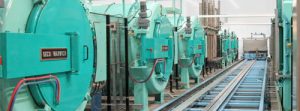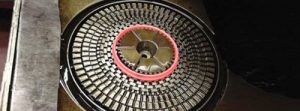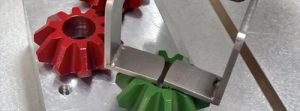
In this column, I will discuss the different types of precipitation hardening stainless steels and discuss their physical metallurgy.
Pearlite was named by Henry Howe for the pearly phase constituent discovered by the English microscopist Henry Clifton Sorby. It consists of alternating plates of ferrite and cementite (Fe3C) (Figure 1). It has a lamellar morphology and is formed from the eutectoid reaction [1]. The lamellae spacing is roughly correlated to the cooling rate or temperature of formation. Faster cooling or low temperature formation yields finer spacing; with slow cooling, or high temperature of formation, the spacing is generally coarser.
When a plain carbon steel of approximately 0.80 percent carbon is slow cooled from the austenite temperature, it will transform completely to pearlite. At carbon contents below 0.80 percent carbon (the eutectoid point), there will be excess ferrite formed, which will form at the grain boundaries of the prior austenite grains.

At carbon contents above 0.80 percent carbon, there will be excess cementite, and the cementite will precipitate on the prior austenite grain boundaries. The remaining microstructure will be predominantly pearlite.
The transformation of austenite (γ-Fe) to pearlite occurs typically in the eutectoid region of the iron-carbon phase diagram. It involves the decomposition of face-centered cubic (FCC) austenite into a lamellar mixture of ferrite (α-Fe) and cementite (Fe3C) known as pearlite. The focus of this article will be on understanding the kinetics and the mechanism of this transformation.
The transformation is driven by the decrease in free energy as the system moves from the high-temperature, single-phase austenite to the lower-temperature, two-phase ferrite and cementite mixture. This process is initiated when the steel is cooled below the eutectoid temperature (approximately 727°C for plain carbon steel), where austenite becomes thermodynamically unstable and decomposes into ferrite and cementite.
Pearlite is a eutectoid mixture of ferrite and cementite (Fe3C). Cementite contains a large portion of carbon, and ferrite has a very low carbon solubility [2] of 0.02 wt.% of carbon at the eutectoid temperature of 723°C and decreases to virtually 0% as the temperature decreases to room temperature. This is readily seen by inspecting the Fe-C phase diagram [3]. As austenite cools, and transforms, the carbon present in the austenite must go someplace. Since ferrite cannot accept more than 0.02% carbon, the carbon must be redistributed, and form Fe3C. This is a diffusion-controlled process.
Pearlite nucleates heterogeneously at grain boundaries, inclusions, or other defects in the austenite matrix. The nucleation process is influenced by the degree of undercooling below the eutectoid temperature: greater undercooling increases the nucleation rate but may affect the lamellar spacing.
After nucleation, pearlite grows by the cooperative movement of ferrite and cementite interfaces through the austenite. The transformation front moves as carbon atoms diffuse from the growing ferrite (which has low carbon solubility) into the cementite, which is carbon rich. The resulting lamellar structure forms as alternating plates of ferrite and cementite, oriented to minimize the diffusion path for carbon and to accommodate volume changes.
The lamellar spacing (distance between adjacent ferrite and cementite plates) is dictated by the transformation temperature: lower temperatures yield finer pearlite, while higher temperatures produce coarser pearlite. The morphology of pearlite, including colony size and interlamellar spacing, significantly affects mechanical properties such as hardness and toughness [4].
Kinetics of the Austenite to Pearlite Transformation
When austenite is held at a constant temperature below the eutectoid point, the transformation to pearlite proceeds at a rate governed by both nucleation and growth kinetics. The Avrami equation is commonly used to describe the fraction of austenite transformed to pearlite as a function of time [5]:

where X(t) is the fraction transformed at time t, k is a rate constant dependent on temperature, and n is the Avrami exponent reflecting the nucleation and growth mechanism [6]. To determine the rate constant and exponent, they are determined empirically by fitting the fraction transformed to elapsed time. For eutectoid steels, n is typically between 2-4, which indicates a mix of nucleation and growth modes [7].
The limitation of this approach is that the Avrami model assumes random nucleation and constant growth rates. This is not always accurate, as real-world applications are rarely isothermal, and there can be widely differing nucleation site, depending on the prior austenite grain size and how dirty the steel is. For continuous cooling, the Scheil additivity rule can be applied [8] [9]. Factors influencing the austenite to pearlite transformation can be found in Table 1.

Conclusion
The austenite to pearlite transformation is a diffusion-controlled process involving the nucleation and growth of a eutectoid lamellar ferrite/cementite two-phase field. Understanding this transformation can help the metallurgist determine the proper process for annealing.
Should you have any questions or comments regarding this article, or suggestions for new articles, please contact the author or editor.
References
- A. P. Mouritz, Ed., “Steels for aircraft structures,” in Introduction to Aerospace Materials, Woodhead Publishing, 2012, pp. 232-250.
- A. S. Pandit, Dissertation: Theory of the Pearlite Transformation in Steels, Cambridge, UK: University of Cambridge, 2011.
- G. Krauss, Steels – Processing, Structure, and Performance, 2nd ed., Metals Park, OH: ASM International, 2015.
- L. Canale, J. Vatavuk and G. E. Totten, “Introduction to Steel Treatment,” Comprehensive Materials Processing, vol. 12, pp. 3-37, 2014.
- E. S. Davenport and E. C. Bain, “Transformation of austenite at constant subcritical temperatures,” Met. Trans., vol. 1, no. 12, pp. 3503-3530, 1970.
- E. B. Hawbolt, B. Chau and J. K. Brimacomne, “Kinetics of austenite-pearlite transformation in eutectoid carbon steel,” Met. Trans. A., vol. 14, no. 9, pp. 1803-1815, 1983.
- A. Gokham, P. Motycka, P. Salvetr, Z. Novy and J. Kotous, “Kinetics of Austenite Decomposition in 54SiCr6 Steel during Continuous Slow Cooling Conditions,” Materials, vol. 16, no. 13, p. 4619, 2023.
- C. Cui, G. Cao, Q. Jiang, X. Kaifeng and L. Zhenyu, “The Generalized Additivity Rule for Thermal Path-Dependent Diffusion-Controlled Phase Transformation by Simultaneous Nucleation and Growth and Its Mathematical Solutions,” Met. Trans. A, vol. 53, no. 10, pp. 3654-3668, 2022.
- C. Verdi and A. Visintin, “A mathematical model of the austenite-pearlite transformation in plain carbon steel based on the Scheil’s additivity rule,” Acta Metallurgica, vol. 35, no. 11, pp. 2711-2717, 1987.






















